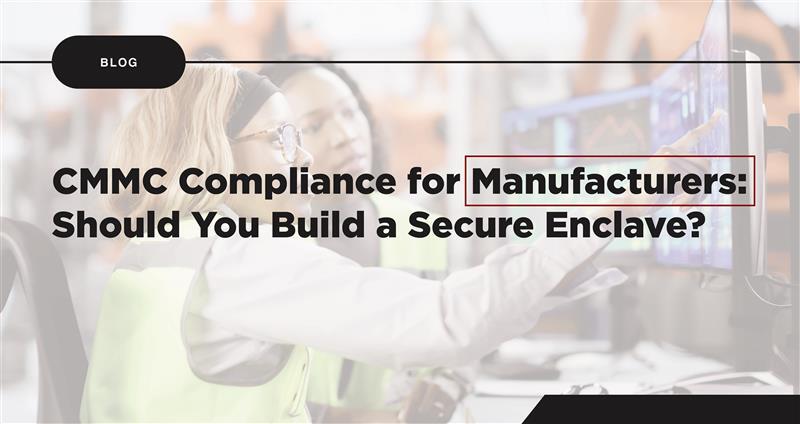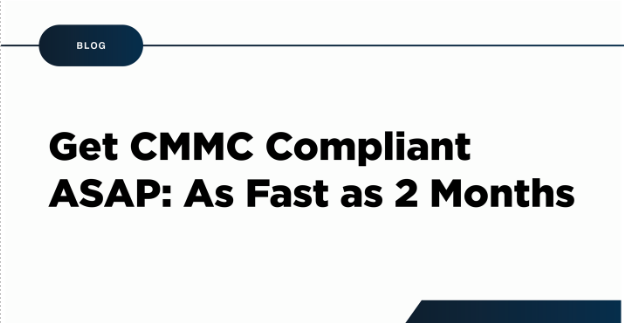What Is a CUI Enclave and When Should You Have One?
A CUI enclave is a stand-alone information system that establishes a software-defined perimeter around its included resources in order to protect sensitive data such as Controlled Unclassified Information (CUI). In this article, we'll explain what Enclaves are as well as their benefits and alternatives.
In today's digital landscape, organizations that work with the DoD and other government agencies are increasingly adopting security-first solutions to enhance their operational efficiency and company compliance.
When it comes to protecting sensitive information and ensuring compliance, there are basically two options:
- Create a boundary around your entire data infrastructure A.K.A. "All-In"
- Create a smaller boundary within your larger infrastructure that is specifically designated for sensitive data A.K.A. "Enclave"
- The CUI enclave approach is often the most cost-efficient way to protect data and it can be simpler to manage because it focuses on the specific components of the organization's infrastructure that are most vulnerable to attack.
- The “All-In” approach allows you to manage your environment to the same baseline versus having two competing standards, but it can also be more complex, resource-intensive, and difficult to manage.
- Organizations who confirm limited CUI data flow exposure on their information system can choose a CUI enclave to avert workload constraints associated with the full infrastructure migration of an All-In approach.
Now let's delve into the world of CUI enclaves and explore two distinct options for data architecture: Enclave and All-In, highlighting their features and benefits.
Option 1: CUI Enclave
What is a CUI Enclave? A CUI enclave can be defined as a stand-alone information system that establishes a software-defined perimeter around its included resources. Its primary purpose is to protect sensitive data and limit the exposure of sensitive data flow, such as Controlled Unclassified Information (CUI).
.png?width=1769&height=1010&name=image%20(22).png)
By implementing a CUI enclave, organizations can mitigate the workload constraints typically associated with a full infrastructure migration, ensuring data integrity and security.
The Enclave approach offers organizations a selective migration strategy. It allows them to isolate specific resources or workloads within a protected environment while keeping the rest of their infrastructure intact and compliant with current compliance mandates.
CUI enclaves are particularly suitable for organizations that require limited CUI data flow exposure. By leveraging CUI enclaves, these organizations can safeguard sensitive information without undergoing a complete infrastructure overhaul – this can also be a first step into creating a compliance boundary in preparation for regulations such as the Cybersecurity Maturity Model Certification (CMMC).
3 Benefits of a CUI enclave:
- Selective protection: Enclaves enable organizations to focus their security efforts on specific resources, allowing for targeted protection of sensitive data.
- Workload optimization: By adopting an enclave approach, organizations can avoid the constraints associated with migrating their entire infrastructure, minimizing disruption and maximizing operational efficiency.
- Scalability and flexibility: Cloud-based CUI enclaves provide the scalability and flexibility of cloud computing while ensuring a secure environment for critical assets.
For Summit 7, we’ve enabled hundreds of DoD contractors with the ability to leverage Microsoft’s Azure Virtual Desktop for their enclave. This gives these companies the ability to run complex workloads within a secure and compliant environment without compromising the ability to compute engineering projects.
Option 2: All-In
The All-In approach, on the other hand, involves lifting the existing infrastructure and migrating it into a full organization's compliant environment. This method is suitable for companies dealing with widespread CUI data flow, where security benefits need to be extended to all assets deemed "in scope" within the information system. It is also applicable to companies who draw most of their revenue from existing contracts that require the strict protection of CUI.
It is crucial for organizations opting for the All-In approach to ensure they migrate to a compliant platform, such as Microsoft Government Community Cloud (GCC) or GCC High.
%20(3).png?width=1463&height=900&name=Enclave-Graphic%20(1800%20%C3%97%201200%20px)%20(3).png)
2 Primary Benefits of The All-In Approach:
- Comprehensive protection: The All-In approach ensures that all assets within the information system are subject to the security benefits of a compliant service, reducing the risk of data breaches across the entire organization.
- Simplified compliance: By migrating everyone to a compliant platform, organizations can streamline their adherence to industry-specific regulations and standards, thereby simplifying the compliance process with a simpler boundary.
Conclusion
Choosing the right deployment strategy is crucial for organizations aiming to protect sensitive data and ensure compliance. CUI enclaves offer a viable solution by providing a software-defined perimeter around specific resources or workloads.
The Enclave approach allows selective protection, minimizing workload constraints, while the All-In approach offers comprehensive protection and simplified compliance.
Ultimately, the choice between Enclave and All-In depends on an organization's specific requirements, the extent of CUI data flow, and their existing infrastructure.
By carefully assessing these factors and partnering with trusted service providers, organizations can leverage the benefits of CUI enclaves to fortify their data security and propel their digital transformation journey forward.
Looking for your next steps to compliance? We're Here to Help

.png)
